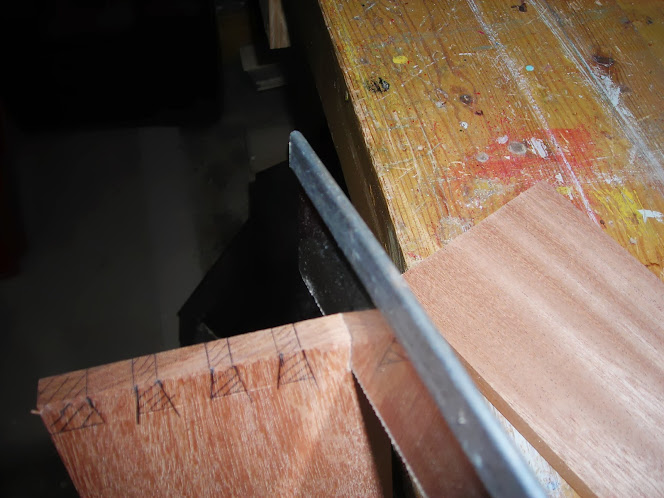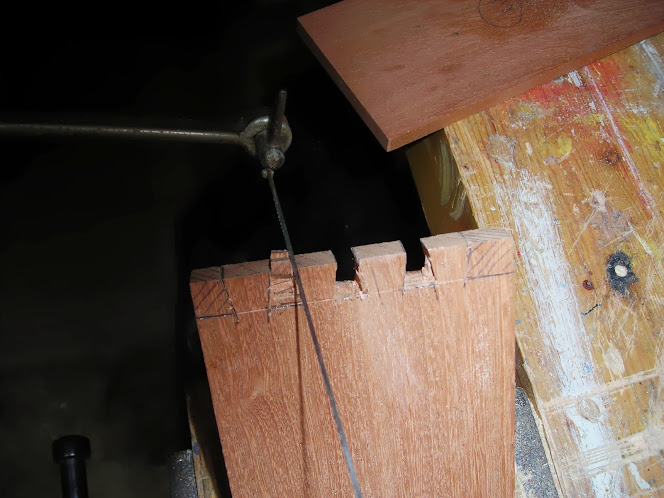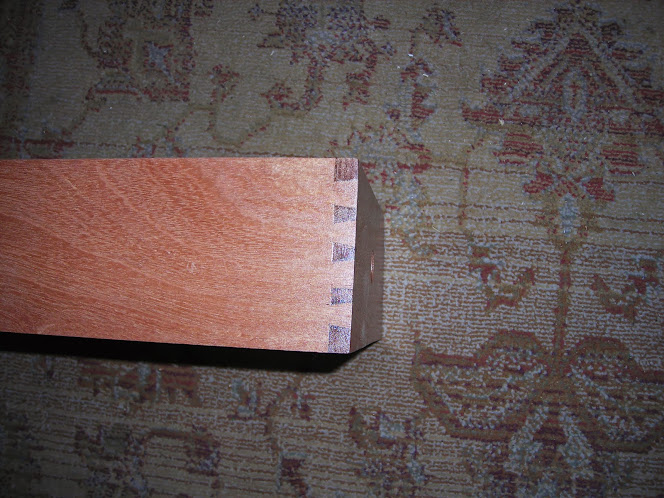Hi all, just wondering whether it's advisable to pare with the grain when resizing dovetail pins? I've read a few books that suggest this and seen a few videos, but I was taught only to pare across the grain in case the grain changes the paring direction and sends the chisel off line. I know the aim is to get the pins right straight off the saw but I'm not quite there yet.
You are using an out of date browser. It may not display this or other websites correctly.
You should upgrade or use an alternative browser.
You should upgrade or use an alternative browser.
paring with the grain
- Thread starter madge
- Start date

Help Support UKworkshop.co.uk:
This site may earn a commission from merchant affiliate
links, including eBay, Amazon, and others.
woodbrains
Established Member
Hello,
Absolutely across the grain. Trying to pare with the grain causes the cut to wander from grain runout.
Don't worry about a little paring. Straight from the saw is the aim, but sometimes, we need to do a little correction. Do not, however, actively err on the side of caution and pare as a matter of course.
Mike.
Absolutely across the grain. Trying to pare with the grain causes the cut to wander from grain runout.
Don't worry about a little paring. Straight from the saw is the aim, but sometimes, we need to do a little correction. Do not, however, actively err on the side of caution and pare as a matter of course.
Mike.
David C
In Memorium
I think your teaching was correct, and those books are written by scoundrells and nincompoops!
Paring with the grain is a very high risk strategy, unless the fibres are perfectly parallel to the edges, and faces.
How often do we find this?
best wishes,
David Charlesworth
Paring with the grain is a very high risk strategy, unless the fibres are perfectly parallel to the edges, and faces.
How often do we find this?
best wishes,
David Charlesworth
Jacob
What goes around comes around.
Paring with the grain is perfectly OK as long as it is parallel to the grain or down hill a touch. If not just do it in the reverse direction. You can get away uphill with a sharp enough blade (obviously) in some wood.David C":3dm1jugl said:.....
How often do we find this?
best wishes,
David Charlesworth
So in theory if one side of a DT pin has uphill grain it will be slightly difficult to pare, but the other side will be easy.
But in reality you just have to get stuck in and you will find the way. Practice, practice!!
Paul Chapman
Established Member
Jacob":3hvakaps said:Paring with the grain is perfectly OK as long as it is parallel to the grain or down hill a touch. If not just do it in the reverse direction. You can get away uphill with a sharp enough blade (obviously) in some wood.
So in theory if one side of a DT pin has uphill grain it will be slightly difficult to pare, but the other side will be easy.
But in reality you just have to get stuck in and you will find the way. Practice, practice!!
What a load of cobblers :lol: Just do it properly across the grain.
Cheers :wink:
Paul
woodbrains
Established Member
Paul Chapman":3hss2rn5 said:Jacob":3hss2rn5 said:Paring with the grain is perfectly OK as long as it is parallel to the grain or down hill a touch. If not just do it in the reverse direction. You can get away uphill with a sharp enough blade (obviously) in some wood.
So in theory if one side of a DT pin has uphill grain it will be slightly difficult to pare, but the other side will be easy.
But in reality you just have to get stuck in and you will find the way. Practice, practice!!
What a load of cobblers :lol: Just do it properly across the grain.
Cheers :wink:
Paul
Yes, and how exactly do we pare slightly downhill when access can only be from one end?
I ask you?
Mike.

£238.91
£360.17
Trend Portable Benchtop Router Table with Robust Construction for Workshop & Site Use, 240V, CRT/MK3
Amazon.co.uk

£17.99 (£1.80 / count)
£27.44 (£2.74 / count)
3M 8822 Disposable-fine dust mask FFP2 (10-pack)
Amazon.co.uk

£24.99
Facemoon Reusable Masks,Safety Masks,Dual Filter Masks, Paint, Dust, Epoxy Resin, Construction, Welding, Sanding, Woodworking, Chemical Reusable Gas Masks
ShenZHEN CIRY MINGYANG LITIAN ELECTRONIC ECOMMERCE

£12.50 (£1,250.00 / kg)
£14.45 (£1,445.00 / kg)
JSP M632 FFP3moulded Disposable Dustmask (Box of 10) One Size suitable for Construction, DIY, Industrial, Sanding, dust protection 99 Percent particle filtration Conforms and Complies to EN 149
Amazon.co.uk
Jacob
What goes around comes around.
Difficult on a DT pin. Or on a thin edge for example.Paul Chapman":88ndx2cq said:Jacob":88ndx2cq said:Paring with the grain is perfectly OK as long as it is parallel to the grain or down hill a touch. If not just do it in the reverse direction. You can get away uphill with a sharp enough blade (obviously) in some wood.
So in theory if one side of a DT pin has uphill grain it will be slightly difficult to pare, but the other side will be easy.
But in reality you just have to get stuck in and you will find the way. Practice, practice!!
What a load of cobblers :lol: Just do it properly across the grain.
Cheers :wink:
Paul
I don't know what madge read but it was obviously wrong in that you can pare with the grain in many circumstances, and sometimes you have no choice anyway.
Jacob
What goes around comes around.
You ask me? I tell you!woodbrains":7kv3c0fk said:.....
Yes, and how exactly do we pare slightly downhill when access can only be from one end?
I ask you?
Mike.
Very carefully! and with a sharp chisel.
I was about to embark on a stroke by stroke description but I thought it would probably confuse you woodbrane.
The main thing madge is just to get stuck in and stop worrying about theories.
G S Haydon
Established Member
- Joined
- 24 Apr 2013
- Messages
- 1,667
- Reaction score
- 223
"Straight from the saw is the aim, but sometimes, we need to do a little correction. Do not, however, actively err on the side of caution and pare as a matter of course"
Keep practicing and and keep any paring with the grain to the absolute minimum with cross grain always the preferred method.
Keep practicing and and keep any paring with the grain to the absolute minimum with cross grain always the preferred method.
woodbrains
Established Member
Jacob":1ovqqkvs said:You ask me? I tell you!woodbrains":1ovqqkvs said:.....
Yes, and how exactly do we pare slightly downhill when access can only be from one end?
I ask you?
Mike.
Very carefully! and with a sharp chisel.
I was about to embark on a stroke by stroke description but I thought it would probably confuse you woodbrane.
The main thing madge is just to get stuck in and stop worrying about theories.
No Jacob, it was a rhetorical question, as the answer is, you can't. If the grain is running against you and you have only access from that direction, you can NEVER cut with the grain. So you pare across the grain, and have done with the issue. It is not hard, there is no reason to try any other way.
Mike.
Jacob
What goes around comes around.
So you cut against it. You just need a very sharp chisel. Try it Mick, you give up too easily!woodbrains":1dxsm5m0 said:..... If the grain is running against you and you have only access from that direction, you can NEVER cut with the grain. .....
Sgian Dubh
Established Member
woodbrains":2ofrpwsn said:You ask me? I tell you!Jacob":2ofrpwsn said:.....
Yes, and how exactly do we pare slightly downhill when access can only be from one end?
Mike.
Actually Mike, you're assertion I believe is incorrect. I know this is not directly related to the original question, and the end purpose of the chiselling is different, also using different types of chisels ... but carvers carve against the grain on a fairly regular basis from what I've seen. I can't describe the technique in detail or with authority because I don't carve and have no interest in learning how; and almost any carving that's been required on any furniture I've worked on over the decades has generally been sub-contracted to someone with those skills-- a bit like subbing out upholstery jobs and passing on the charge to a client, along with a suitable mark-up, naturally! Slainte.woodbrains":2ofrpwsn said:... it was a rhetorical question, as the answer is, you can't.
Mike.
Jacob
What goes around comes around.
It's like planing against the grain. Sometimes you can, sometimes you can't , but a sharp tool will certainly help.
woodbrains
Established Member
Sgian Dubh":1u56l54y said:woodbrains":1u56l54y said:You ask me? I tell you!Jacob":1u56l54y said:.....
Yes, and how exactly do we pare slightly downhill when access can only be from one end?
Mike.Actually Mike, you're assertion I believe is incorrect. I know this is not directly related to the original question, and the end purpose of the chiselling is different, also using different types of chisels ... but carvers carve against the grain on a fairly regular basis from what I've seen. I can't describe the technique in detail or with authority because I don't carve and have no interest in learning how; and almost any carving that's been required on any furniture I've worked on over the decades has generally been sub-contracted to someone with those skills-- a bit like subbing out upholstery jobs and passing on the charge to a client, along with a suitable mark-up, naturally! Slainte.woodbrains":1u56l54y said:... it was a rhetorical question, as the answer is, you can't.
Mike.
Hello,
Carvers actually carve across the grain if they can't carve with it and only against as a last resort. Almost all carving to lower a background in relief carving is done across the grain, in fact. Chris Pye has some good online tutorials on the methods, which I am currently watching ( and trying) with interest.
During dovetaling, paring cross grain eliminates the chances of the cut wandering, if the grain goes where you don't want the cut to go. There is almost always some runout, so usually one side of every pin will have adverse grain direction. Can't see the biggie with just paring in from the side across grain rather than ..down along it. There is the same amount of material to remove, same thin slither, which ever direction. You just mitigate the runout problem if you go across.
Mike
Derek Cohen (Perth Oz)
Established Member
I agree with Jacob (yes I know, I will be struck down by lightning for this! :lol: ).
Sometimes I do resort to trimming a dovetail by paring with the grain - and, yes, the grain needs to be straight, and yes, the chisel must be sharp. But it can be done, does get done, and if you watch the cut developing, you can stop before you get into trouble and correct the this.
Regards from Perth
Derek
Sometimes I do resort to trimming a dovetail by paring with the grain - and, yes, the grain needs to be straight, and yes, the chisel must be sharp. But it can be done, does get done, and if you watch the cut developing, you can stop before you get into trouble and correct the this.
Regards from Perth
Derek
Jacob
What goes around comes around.
No you 'll be OK Derek. There must be thousands out there who have very reluctantly had to agree with me and lived to tell the tale. It's the others who get struck by lightning, or get sudden attacks of boils etc :roll: 8)I agree with Jacob (yes I know, I will be struck down by lightning for this! :lol: )....
Derek
Phil Pascoe
Established Member
charvercarver
Established Member
- Joined
- 30 Apr 2010
- Messages
- 64
- Reaction score
- 0
woodbrains":2eixy6jk said:Hello,
Carvers actually carve across the grain if they can't carve with it and only against as a last resort. Almost all carving to lower a background in relief carving is done across the grain, in fact. Chris Pye has some good online tutorials on the methods, which I am currently watching ( and trying) with interest.
I find going across the grain with a slicing cut to be the cleanest and most controlable type of cut, personally I prefer it to going with the grain most of the time. That said with a high angle grip you can carve against the grain i.e. setting in by slicing.
Dunno if that helps with dovetails though. I'm not sure when you wouldn't be able to go across the grain.
adzeman
Established Member
I am a bit confused over why one requires to resize a dovetail?
I am at present constructing drawers for my tool cabinet and due to losing daylight have come in and begone reading this thread.
To help I took photo's of the stages.
First I cut the taitls with a back saw.

Then with a beveled chisel cut the base of the sockets with two sharp taps the centre is cut out with a coping saw. This require a bit of careful trimming/cleaning up paring doown vertically across the grain.

The best bit sanding down, Its like photography when an image appears when developing seeing the dovetails take shape

The finished drawer

No paring across the grain
I am at present constructing drawers for my tool cabinet and due to losing daylight have come in and begone reading this thread.
To help I took photo's of the stages.
First I cut the taitls with a back saw.

Then with a beveled chisel cut the base of the sockets with two sharp taps the centre is cut out with a coping saw. This require a bit of careful trimming/cleaning up paring doown vertically across the grain.

The best bit sanding down, Its like photography when an image appears when developing seeing the dovetails take shape

The finished drawer

No paring across the grain
dm65
Established Member
That's because you're obviously well practiced and get it right each time - op is obviously expecting to 'fine tune with heandtools' as Norm would sayadzeman":99suoi9c said:No paring across the grain
I will be embarking on your method soon, having also seen it recently on youtoob and if I get it right within a dozen attempts, I'll even show the kids and live with the consequences
Similar threads
- Replies
- 0
- Views
- 154
- Replies
- 22
- Views
- 4K



























